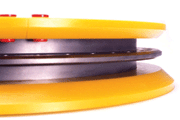E-Archive
Articles
in Vol. 4 - July Issue - Year 2003
Different Masking Solutions for Peening Applications


Gerard Poly Mouldings is a UK based engineering/moulding company specialising in the design and manufacture of moulded masking and protection to the gas turbine industry and other high specification industries. The main areas of focus for masking are grit blasting, shot peening, metal spray, painting and vibratory polishing.
Today within the surface finishing industry one sees advances in machinery aimed at increasing productivity and repeatability. Whilst these advances continue year on year and the imagination of the engineers is driven by these innovations one tends to forget about masking.
Masking of components and surfaces is a necessary part of every surface finishing process. The process appears simple enough and that is probably why in many cases it is neglected but after the initial capital investment in the machinery it is the single highest cost factor incurred in day to day operations.
Within the process of shot peening, there are several methods of masking. Firstly and probably the most common form of masking is the use of adhesive tape, secondly there is moulded masking and lastly UV curable resins. All methods of masking have their good and bad points.
Tape Masking
Tape masking is the most common form of masking partly because it is viewed as cheap and quick, the operator is already on site and all you need is a roll of tape to get the job processed. This philosophy is appropriate in an environment where small batches of components require non-intricate masking, taking into consideration the unlikely event that the same parts will not return on a regular basis. When there are large batches, or intricate masking required with the high probability of the job returning, this method becomes expensive. Labour becomes the major cost factor, other factors that are associated with manual labour doing the masking is absenteeism and the repeatability of the masking.
The virtues of tape are that it can be applied to any surface and there is no thickness to it so there are is no shadow masking, this is especially helpful when masking a surface perpendicular to the surface to be peening when full coverage is required.
However, tape must also be removed with care so the component is not scratched, this introduces more labour to the process and there are times depending on the brand of tape and the climate of the workshop that adhesive residue is left on the component. This creates an additional cleaning process and above all it is important that the residue is not on a surface to be peened so the surface structure of the component is not contaminated.
In summary, tape masking is immediate, the initial cost is cheap, it is adhesive and no shadows are created but against it are that it is time consuming and expensive in the long run and repeatability is not guaranteed.
Moulded Masking
The second most common method of masking is moulded masking, the main attractions of this method are that it is quick, reusable and offers repeatability. This all sounds very well but it does come at a cost both financially and time-wise. Initially to determine whether a moulded mask is practical it is necessary to ascertain that the job will be on going and there is sufficient part volume.
Moulded masking is neglected owing to people’s perception of prohibitive tooling costs at start-up. This is true of many moulding companies. However within the gas turbine industry there are companies that do not charge tooling and simply sell the masks. Although the masks are reusable they do wear out and additional moulding work is necessary so these companies amortise their development costs taking the long-term view. Speed and repeatability do not come automatically with moulded masking for when the tooling is not well engineered the component fit can be inaccurate and tight. It is advisable to work with a company that understands shot peening and gas turbine engines as this will ensure the correct material selection is made and your time input is not wasted whilst away from production. A note of caution is that certain moulded materials contain chemicals that will react with certain alloys such as titanium.
Most shot peening applications that call for moulded masking are blades and vanes. There is also another significant benefit in that with an interface the mask acts both as a mask and fixture. Machine position repeatability reduces set-up times and time wasted repositioning nozzles.
Masks for fan discs, spools and turbine discs are uncommon because the volume is significantly lower than that of blades but for larger parts the cost of single-use masking materials (tape, UV resin) must be considered as well as the labour savings. A fan disc hub can be prepared in 5 minutes compared with hours of intensive masking work. The one draw back of moulded masking is storage, when there is a lot within a workshop, thought must be given to storage otherwise operators will spend production time looking for the correct mask and any gains vanish.
For Information:
Gerard Poly Mouldings
Nottingham NG9 6DX, England
Tel. +44.115 972 6540, Fax 115 946 2163
E-mail: GPMUK@aol.com



























